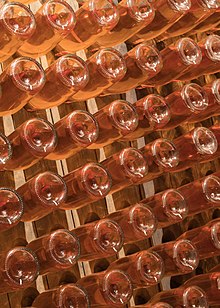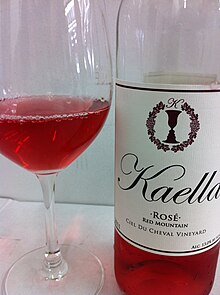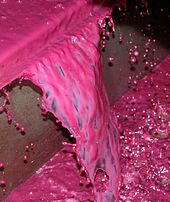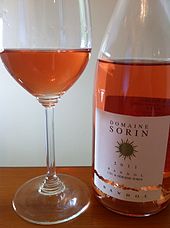Rosé


A rosé (French:
There are three major ways to produce rosé wine: skin contact, saignée, and
When rosé wine is the primary product, it is produced with the skin contact method. Black-skinned grapes are crushed and the skins are allowed to remain
When a winemaker desires to impart more
The simple mixing of
History

It is not known when the first wine labeled as a rosé was produced, but it is very likely that many of the earliest red wines made were closer in appearance to today's rosés than they would be to modern red wines. This is because many of the winemaking techniques used to make today's darker, more tannic red wines (such as extended maceration and harder pressing) were not widely practised in ancient winemaking. Both red and white wine grapes were often pressed soon after harvest, (with very little maceration time) by hand, feet or even sack cloth, creating juice that was only lightly pigmented.[7]
Even after
Similarly, in the early
Even as Champenois moved towards producing sparkling wines, they continued to produce both sparkling and still rosés often by means of blending a small amount of red wine to "color up" an already-made white wine. The depth of color was dependent on the amount red wine added, with the red wine having more influence on the resulting flavor of the wine if added in larger volumes.[1]
After World War II

The history of rosé would take a dramatic turn following the conclusion of World War II when two Portuguese wine producer families both released sweet, slightly sparkling rosés to the European and American markets. These wines, Mateus and Lancers, would go on to set record sales in Europe and the US and dominate the Portuguese wine industry for most of the 20th century, but their popularity has declined in the recent years of the 21st century. While they still have a presence in the European and US markets, the trend towards traditional, drier rosés, as well as the development of American "blush" wines like White Zinfandel, have cut into their market shares.[1]
In the early 1970s, demand for white wine exceeded the availability of white wine grapes, so many California producers made "white" wine from red grapes, in a form of saignée production with minimal skin contact, the "whiter" the better.
In 1976, wine writer
Although "blush" originally referred to a color (pale pink), it now tends to indicate a relatively sweet pink wine, typically with 2.5% residual sugar;[14] in North America, dry pink wines are usually marketed as rosé but sometimes as blush. In Europe, almost all pink wines are referred to as rosé regardless of sugar levels, even semi-sweet ones from California. As the term rosé regained popularity in the US market, shares of wine labeled "blush" declined from 22% of all wines consumed in the US in 1997 to 15% in 2003.[1]
In the United States, a record 2005 California crop has resulted in an increased production and proliferation of
Rosé became a viral drink in 2015, with men who drink rosé being referred to as brosé.
Winemaking methods

Rosés can be produced in a variety of ways with the most common method being early pressing of red grape varieties after a very short period, usually 12–24 hours, of skin-contact (maceration). During maceration,

Saignée
The saignée (French:
Vin gris
Unlike the maceration method which gives some, albeit very brief, time for the juice to be in contact with the skins
Decolorization
Another method of producing rosé is to severely decolorize a red wine using absorbent charcoal such as activated carbon. This purer form of charcoal obtained by the dry distillation of carbon compounds (such as wood or peat) has a high ratio of surface area to weight that adsorbs color compounds as well as other phenolics and colloids in a wine. While it can be used to decolorize a wine, often much more than just color is stripped from the wine which makes this method very rarely used in the production of quality rosés.[1]
Color


With the exception of very few varieties, known as

Anthocyanins have the ability to change into three different forms—colorless, red and blue—depending on the
According to Conseil Interprofessionnel des Vins de Provence[20] in France, rosés in Provence display one of the different colors: melon (cantaloupe), peach, redcurrant, grapefruit, mango, mandarin.
Many studies have shown that the color of wine influences consumers' perceptions about the wine.[4][21][22] While these studies have shown that consumers tend to prefer on visual inspection the darker rosés, in blind taste tests where color could not be visually discerned (such as using black wine glasses), often consumers preferred the lighter-colored rosés.[4]
For these reasons, many rosé winemakers are mindful of the color quality of their rosé and make winemaking decisions based on this factor. This includes the extent of maceration, whether or not to do a saignee from a darker red wine and even to do a color adjustment by blending in some finished red wine in order to reach the desired color.[4]
Aromas and flavors

The aromas and flavor of rosés are primarily influenced by the particular grape varieties used to produce the wine, but the method of production also plays an important part. The light, fruity character of many rosés come from volatile
The stability of these aromas is very dependent on the amount of anthocyanins and other phenolics that protect these compounds from oxidation. One of the reasons why rosés have a very limited shelf-life is because of their low phenolic levels due to the very limited skin contact and extraction time. Within a year of production, the level of 3-mercaptohexanol-1-ol in the wine has usually dropped to half its fermentation level, with the presence of 3-mercaptohenyl acetate undetectable in most wines.[4] This is why most wine experts recommend that rosés be consumed as soon after release as possible.[23]
French rosés
Many of the earliest red wines produced in such notable wine regions as Bordeaux,
Provence

Rosés account for vast majority of Provence's wine production, ranging from half to almost two thirds of all the wine produced in the region
The large
The
Located in the hilly central region of Provence, rosés account for almost two-thirds of the production in the
The
Around the city of Nice in southeast Provence is
Tavel

While most of the southern
Located 10 miles southwest of the
While Tavel rosé can be made using the saignee and skin-contact method, the tradition in the region is to do a type of
Other Rhône rosés
Outside of Tavel, rosés are produced in some significant quantities in the Gigondas AOC on the eastern side of the Rhône valley. Here at least 15% of the wine must be made from Syrah and Mourvedre with Grenache permitted to make up to 80% of the blend and Cinsault and Carignan playing minor roles. Next door to the south in the Vacqueyras AOC rosés only account for around 4% of the yearly production using the same grapes as Gigondas.[25]
Across the river from Châteauneuf-du-Pape just north of Tavel is the Lirac AOC which, like it southern neighbor, has a long history of exporting dry rosé wines to the United States and United Kingdom. While often overshadowed by neighboring Tavel, some critics, such as wine expert Oz Clarke, describe them as having noticeable strawberry notes and being "breezier, more refreshing" than its more prominent neighbor.[2] However, rosés usually account for less than a fifth of this region's yearly production.[25] Here in the sandy soil on the banks of the Rhône, Grenache makes up to 40% of the blend with Cinsault, Mourvedre, Syrah and Carignan making up the remainder.[24]
Loire
Rosé making has a long history in the Loire valley, particularly in the
For most of the 20th century, the sweeter Rosé d'Anjou was the most prominent Rosé but even as the trend of consumers moving to more drier versions of rosé, the AOC still produces an estimated 18 million bottles of wine a year.[2] In addition to Groslot, Gamay and Malbec are also permitted varieties in the wine.[25]
A larger Rosé de Loire appellation exist that includes wines made from Anjou, Saumur and Touraine. Cabernet grapes must account for at least 30% of the blend with Groslot, Pineau d'Aunis, Pinot noir and Gamay permitted to fill out the rest of the blend. According to wine expert Jancis Robinson, the wines are always dry with a quality level that falls somewhere between Rosé d'Anjou and Cabernet d'Anjou.[1] Wine expert Karen MacNeil describes well made examples of Rosé de Loire as being fruity with light cherry flavors and moderate acidity.[23]
Champagne

Rosé Champagnes account for between 3-5% of Champagne's yearly production.
In the
Other French regions

In
In the
In
In
Other European rosés
Italy

Like France, rosés are made throughout Italy with the style and grape varieties used changing depending on the region and local climate. The long history of Italian rosés, particularly in the warm southern part of the country, stem from difficulties in the early days of winemaking to make dark, fully colored dry red wines without temperature controlled fermentation vessels. As the must macerated with the skins, the intense heat of the process would often kill the yeast resulting in a
The Italians have several terms for rosé style wines beginning with the term rosato that is a permitted wine style in several
Today, Italian rosés are most often made by the short maceration method though some regions do have a tradition of blending red and white wine grapes together to make a lightly colored wine.

In the
Occhio di Pernice
In
Germany, Austria, Switzerland
In Germany, several regions are noted for their distinct style of rosé (German rosewein or roseewein). Several terms are used to denote these different styles depending on how the wine was made, from what grapes and in what region. The term Weißherbst is a type of German rosé made from a single variety of grape with that particular variety needing to be denoted on the
In the
In
In the eastern regions of
Spanish rosado

In Spain, rosés are known as rosado and are produced throughout the country with the
In the
Other
Portugal
In 1942, a winemaker from
The history of Lancers, the other, notable Portuguese sparkling rosé that rose up after World War II, is quite similar to Mateus. The winemaking family of José Maria da Fonseca in the Setúbal DOC, one of the oldest Portuguese wine producers, received word from a distributor in New York City about American servicemen returning from Europe having a taste for many of the new wines they tried on their tours. In 1944, Fonseca released Lancers in a distinctive stone crock. Today, the wine is fully sparkling, using the "continuous method" of fermentation in large stainless steel tanks instead of individual wine bottles. While its rival, Mateus, is mostly still found in Europe, Lancers has remained in the North American market.[1]
New World rosés
White Zinfandels and blushes
While there have been rosés made in the European style throughout the American winemaking history, it wasn't until the end of the 20th century that "pink wines" became a truly significant segment of the American wine market. In what has been described by wine experts such as Jancis Robinson as a "
The term "blush" also originated in the 1970s when wine writer Jerry Mead visited the Sonoma County winery Mill Creek Vineyards and sampled a pale, pinkish wine that the winery made from Cabernet Sauvignon. The winemaker was thinking of calling the wine "White Cabernet" but Mead suggested the term "blush" instead. However, by the 1980s, white wines were still extremely popular among American consumers. Seizing on this interest, makers of sweeter "blush" style rosés began affixing the terms "white" or "blanc" to the varietal name on their wine labels anyway — White Zinfandel, Cabernet Blanc, White Merlot, etc. Throughout the rest of the 20th century, these sweeter blush wines saw tremendous popularity among American consumers but their numbers had started to decline by the turn of the 21st century falling from representing 22% of all the wines consumed in the US market in 1997 to 15% in 2003.[1]
Today, White Zinfandels are considered part of the "blush wine" category of noticeably sweet, pale pink wines that often have very slight
Long Island Rosés
Since the early 1990s,
See also
- Clairet, a very dark rosé sometimes considered its own category of wine
- Rosé apple cider, made using red-fleshed applecrabs
- lemon juice
References
- ^ ISBN 0-19-860990-6
- ^ ISBN 0-316-72654-0
- ^ Lichine, Alexis (1967). Alexis Lichine's Encyclopedia of Wines and Spirits. London: Cassell & Company Ltd.
- ^ ISBN 9780123736468
- ^ Lourens, Karen. "Focus on Rosé". Anchor Yeast. Archived from the original on 27 October 2007.
- ^ The Wine Doctor, Glossary: S Archived 2011-12-15 at the Wayback Machine. Retrieved 21 October 2008.
- ^ ISBN 0-671-68702-6
- ^ a b c d Mead, Jerry D. (1996) Mill Creek Revisited Mead on Wine Vol. I No. 6
- ^ Dunne, Mike (2005) Wines of yesteryear still kicking. The Sacramento Bee, 29 July 2005
- ^ Murphy, Linda (2003) White Zinfandel, now 30, once ruled the U.S. wine world San Francisco Chronicle, 3 July 2003.
- ^ Mead, Jerry D. (1996) Mill Creek Revisited Mead on Wine Vol. I No. 6; Mead says this story is also mentioned in Leon Adams' The Wines of America
- ^ USPTO Trademark #73164928 "Blush"
- ^ Mill Creek Vineyards Our Wines
- ^ California Wine Institute. "California Rosé and Other Blanc de Noir Wines".
- ^ Voss, Roger. Heimoff, Steve Wine Enthusiast Online, July 2007
- ^ Wyma, Chloe (3 June 2015). "Make Way for Brosé: Why More Men Are Drinking Pink". GQ.
- ^ Wilson, Jason (29 July 2015). "Brosé: wine for the angsty bro who blushes when he 'drinks pink'". The Guardian.
- ^ "How Frosé Became the Drink of the Summer—and How to Make It at Home". MyRecipes.
- ^ Lucy Shaw "Saignée rosé “not true rosé”" The Drinks Business, 30 May 2012
- ^ Provence rosés colors on Conseil Interprofessionel des Vins de Provence website (English)
- S2CID 21720724.
- ^ A. Tromp and C.J. Van Wyk The influence of color on the assessment of red wine quality Proceedings of the South African Society for Enology (1977)
- ^ ISBN 1-56305-434-5
- ^ ISBN 1-55297-720-X
- ^ ISBN 0-7645-5354-2
- ISBN 0-7513-3740-4
- ^ "Tendance Rosé : Les AOC et IGP du Languedoc-Roussillon en tête des ventes".
- ^ ISBN 1-4000-9774-6
- ^ ISBN 9780756686840
- ^ e-wineplanet.com Germany
- ^ ISBN 9780756686840
- ISBN 1854105140
- ^ ISBN 9780756686840
- ^ McInerney, Jay (5 June 2010). "For Summer, Think Pink". Wall Street Journal – via www.wsj.com.
- ^ "Cinque Family Wines". Cinque Family Wines.
Further reading
- Gabay, Elizabeth (2018). Rosé: Understanding the pink wine revolution. The Classic Wine Library - Infinite Ideas Limited. ISBN 978-1-910902-71-4. Retrieved 21 January 2018.
